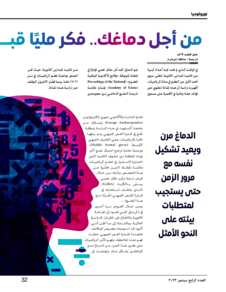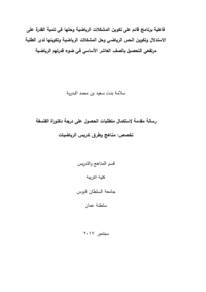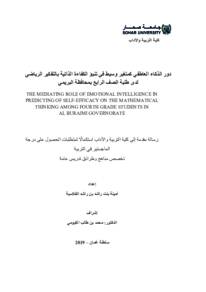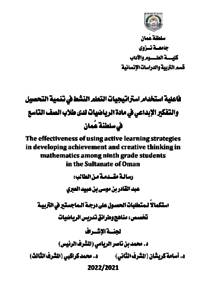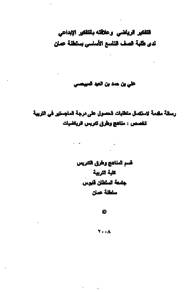Document
أثر استراتيجيات التدريس القائمة على نظرية الذكاءات المتعددة في تحصيل الطلبة و تفكيرهم الرياضي
Publisher
جامعة السلطان قابوس
Gregorian
2007
Language
Arabic
Subject
English abstract
This study aimed to investigate the effect of teaching mathematics by using multiple intelligences strategies on achievement and mathematical thinking among 10th students in public school. The sample of study consisted of (60) students in grade 10 from Saif bin Hubira basic school (5-10). The sample was divided into two groups : An experimental group of (30) students who were taught according to multiple intelligences strategies. The second was the controlled group which also consisted of (30) students and they were taught according to traditional method. We made sure that there is equivalent between the two groups concerning the previous achievement and the previous mathematical thinking. In order to measure the effect of the multiple intelligences strategies on the experimental group the researcher used an achievement test that consisted of (25) items and mathematical thinking test that consisted of (36) items. Both tests were and validated by a number of specialists. According to the Cronbach Alpha measuring method the internal consistency of the achievement test was (0.79) and the reliability of mathematical thinking test was (0.81(To analyze the data the researcher used the following means , standard deviation , T-test This study reached the following conclusions: There were statistically significant differences (a=0,001) between the students means of scores in the achievement test due to the strategies of teaching, favoring the students taught mathematics by multiple intelligences strategies. There were statistically significant differences (a=0,003) between the students means of scores in the mathematical thinking test due to the method of teaching, favoring the students taught mathematics by multiple intelligences strategies. In the light of these conclusions, the study recommended using multiple intelligences strategies for teaching mathematics.
Description
رسالة جامعية
Member of
Resource URL
Arabic abstract
هدفت الدراسة إلى تقصي أثر تدريس الرياضيات باستخدام استراتيجيات الذكاءات المتعددة في التحصيل الدراسي والتفكير الرياضي لدى طلاب الصف العاشر. وتكونت عينة الدراسة من (60) طالبا من طلاب الصف العاشر بمدرسة سيف بن هبيرة للتعليم الأساسي (۰-۱۰). وقد تم تقسيم عينة الدراسة إلى مجموعتين : مجموعة تجريبية وتكونت من (۳۰) طالبا تم تدريسها وفقا لاستراتيجيات الذكاءات المتعددة، ومجموعة ضابطة وتكونت من (۳۰) طالبا تم تدريسها بالطريقة التقليدية. وتم التأكد من تكافؤ المجموعتين من حيث التحصيل الدراسي والتفكير الرياضي قبليا. وللتحقق من أثر المعالجة التجريبية، تم استخدام اختبار تحصيلي مكون من (۲۰) مفردة. وقد تم التحقق من صدقه بعرضه على عدد من المتخصصين كما تم حساب ثبات الاختبار والذي بلغ (۰٫۷۹) وفقا المعادلة ألفا كرونباخ، وأيضا تم استخدام اختبار التفكير الرياضي مكون من (۳۹) مفردة، وتم التحق من صدق محتواه وحساب معامل ثباته أيضا باستخدام معامل ألفا كرونباخ فوجد مساويا (۰٫۸۱). ولتحليل البيانات استخدم الباحث المتوسطات الحسابية، والانحرافات المعيارية، واختبار ت (- t test ) ، وقد توصلت الدراسة إلى النتائج التالية : - وجود فروق ذات دلالة إحصائية عند مستوى ( ه = ۰٫۰۰۱) بين متوسطي درجات الطلاب في التطبيق البعدي لاختبار التحصيل الدراسي تعزى لاستراتيجيات التدريس، ولصالح الطلاب الذين درسوا وحدة "الدوال المثلثية باستخدام استراتيجيات الذكاءات المتعددة . - وجود فروق ذات دلالة إحصائية عند مستوى ( ه = ۰٫۰۰۳) بين متوسطي درجات الطلاب في التطبيق البعدي لاختبار التفكير الرياضي تعزي لاستراتيجيات التدريس، ولصالح الطلاب الذين درسوا وحدة "الدوال المثلثية باستخدام استراتيجيات الذكاءات المتعددة. وفي ضوء تلك النتائج أوصت الدراسية باستخدام استراتيجيات الذكاءات المتعددة في تدريس الرياضيات.
Category
Theses and Dissertations


